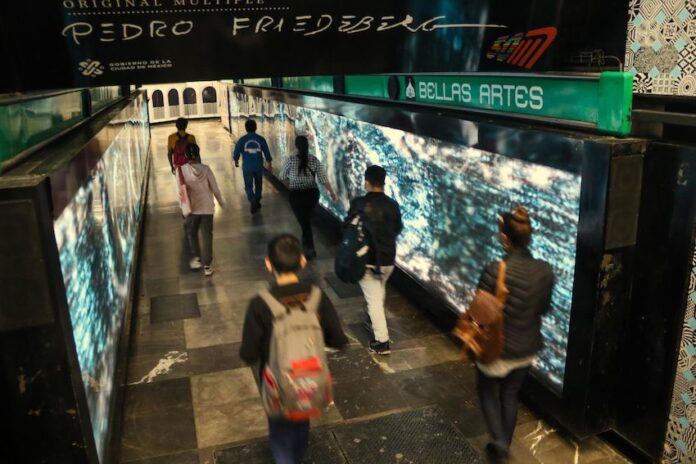“The Mexico City Metro is much more than a public transport system. It has become a microcosm in constant movement, whose daily life reflects the diversity, emotions and above all the identity of the people who travel in it.”
— Quote from the photography exhibition “Inquieta Cotidianidad” in the La Raza station
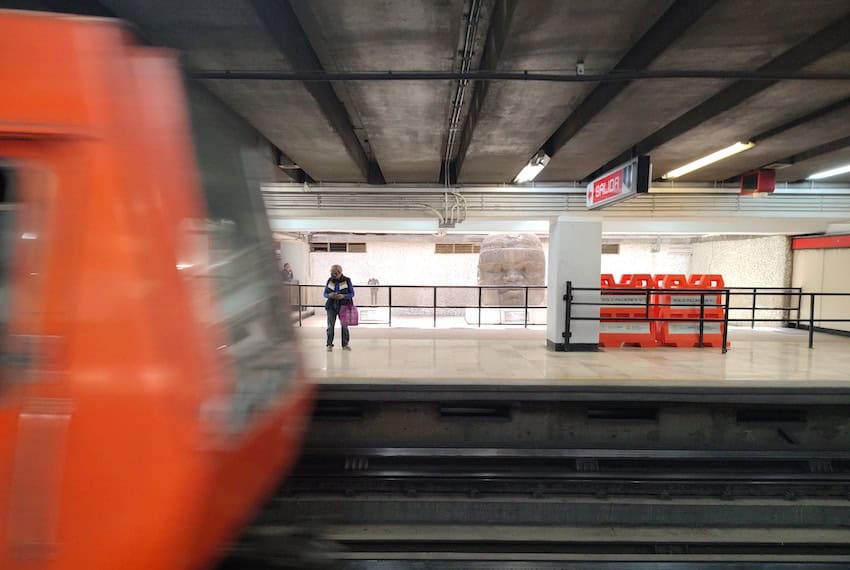
The song “Sandunga” by Puerto Rican “King of Reggaetón” Don Omar blares from a television to a captive audience of commuters standing just behind an embossed yellow line.
Below the TV is a Maya stele from the Izapa archeological site in Chiapas featuring intricate bas-reliefs. This juxtaposition of culture — the ancient and the very modern — plays out on a platform of the Bellas Artes metro station in the subterranean heart of Mexico City.
I fell in love with Mexico City’s metro more than a decade ago when I undertook a project to visit every station of the system (there are 163) and the surrounding neighborhoods. The pulsating energy of the system, its incessant commerce and crush of commuters all enchanted me.
So did the amazing and incredibly varied expressions of culture on display: underground urban art, pre-Columbian relics, detailed murals, live music, the skeletal remains of an extinct animal, photography exhibitions, performers of all stripes, and stained glass windows casting technicolor shadows.
All this, and much, much more, is available to Mexico City residents and visitors alike for the bargain-basement admission price of 5 pesos (US $0.25), the cost of getting through the turnstiles at any station along the 12 color-coded lines.
I have enjoyed this visual and auditory feast for years as I traveled around Mexico City, but until a recent Friday, I hadn’t specifically set out to experience it, to purposefully make a day of it like one does meandering through an expansive art museum.
Line 3 wonders: The world’s largest art gallery and a pyramid — yes, a pyramid!
It was Friday morning rush hour — best avoided if possible — when I entered the División del Norte station, where legendary Mexican composers and musicians such as Agustín Lara, Juan Gabriel, Ana Gabriel and Consuelo Velázquez are honored in a permanent exhibition.
I zipped up the olive green Line 3 to the Hidalgo station, home to the largest public art gallery in the world, according to the Sistema de Transporte Colectivo, the official name of the metro system. The “Involuntary Mexico” gallery, curated by British artists Millree Hughes and Paul Conneally, was inaugurated here in 2019 as part of the 50th anniversary celebrations of the Mexico City Metro. It features art by more than 300 artists from 50 countries, including a wide array of eye-catching photographs and eclectic, collage-style murals, some of which depict scenes of urban decay.
While there is an international flavor to the aesthetic delights of Metro Hidalgo, the Bellas Artes station — just one stop over on the blue Line 2 — is distinctly Mexican.
Here you will find an extensive collection of pre-Columbian relics including the Maya stele mentioned above, a Toltec Chac Mool sculpture and a Huastec “feminine figure” carved out of stone. You can also see a wide array of painted artworks, including “El Mural de Bonampak,” a reproduction by Guatemalan-Mexican artist Rina Lazo of a fresco on an interior wall of the imposing structure at the Bonampak archaeological site in Chiapas.
For a more surreal experience, take a walk through the Galería Metro (the metro gallery), replete with trippy Pedro Friedeberg murals and light displays. The journey through the gallery will take you to the Line 8 side of the Bellas Artes station, where more very Mexican murals await, including one featuring El Palacio de Bellas Artes (The Palace of Fine Arts), from which the station derives its name.
Perhaps the cultural pièce de résistance of the Mexico City Metro is the Ehécatl Pyramid, located in the Pino Suárez station in the historic center of the capital. Uncovered in 1967 during the construction of the station, the pyramid is dedicated to the wind deity Ehécatl, one of the manifestations of the feathered serpent deity Quetzalcóatl.
The pyramid, part of a larger ceremonial complex that is believed to have been built between 1400 and 1521, is “Mexico’s smallest archaeological area,” according to the National Institute of Anthropology and History (INAH). And that’s not the only superlative that applies to the structure.

The travel publication México Desconocido says that the pyramid, which is also visible from street level, is “the busiest” archaeological site in the country given that 54 million people pass by it every year while using the Pino Suárez station.
During my 15-minute visit, I didn’t see anyone else stop to purposefully take in the pre-Columbian structure built centuries ago by the Mexica people, but one amorous young couple used it as a romantic backdrop for their very enthusiastic public display of affection.
Find mammoth bones on Line 4 and Olmec heads on Line 6
After admiring the pyramid, I rode along the pink Line 1 — the metro system’s inaugural line — to the Candelaria station, located adjacent to the Chamber of Deputies, Mexico’s lower house of Congress. A stained glass wall reminiscent of the De Stijl art movement greeted me after I ascended a flight of stairs, casting a multi-colored shadow on the station floor.
I paced through a broad, brightly-lit transbordo (transfer) tunnel to get to Line 4 to take a train up to the Talismán station in the northern Mexico City borough of Gustavo A. Madero. Mammoths were on my mind.
Below a glass dome at the eastern entrance to Metro Talismán lies the skeleton of a mammoth found in 1978 during the construction of Line 4 of the metro. Experts estimate that the four-meter-tall adult specimen died between 10,000 and 12,000 years ago “without the intervention of man.” The presence of the extinct animal’s bones in the station is a testament that the Mexico City Metro is not just an immense art and anthropology museum, but a natural science one as well.
Commuters also come face-to-face with the past (quite literally) in the Tezozómoc station, where giant Olmec heads and other stone artifacts are on display.
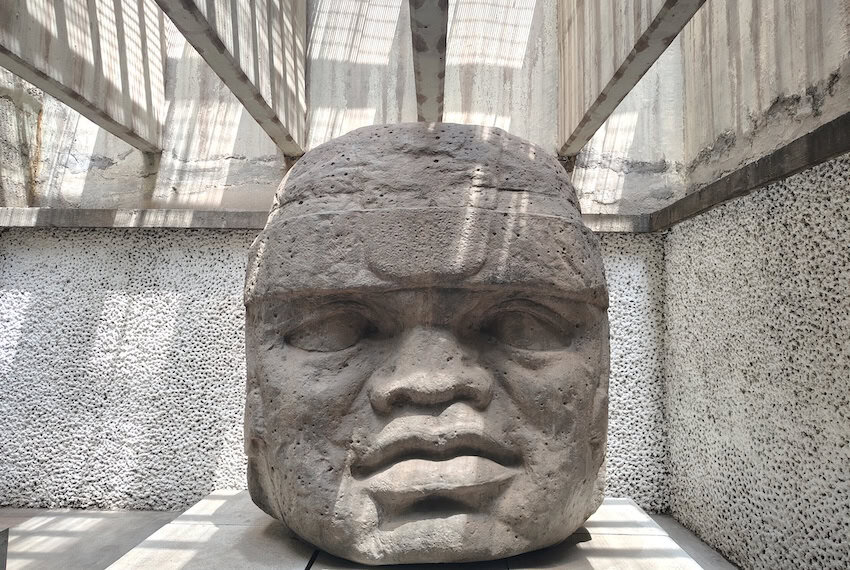
These cabezas colosales (colossal heads) were found in the southeastern Gulf region of Mexico, where the “mother culture” of Mesoamerica — the Olmec civilization — once thrived. Located on the red Line 6 in the north of Mexico City, Tezozómoc is one of the farther-flung stations on the metro system, but the trip to see the Olmec heads is worth it. These impressive fixtures form a striking juxtaposition with the so-called gusanos naranja (orange worms) as they whiz into the station.
The Tunnel of Science
I ventured back along the red line to Metro Instituto del Petróleo, where oil drums decorate the station’s interior. From there I traveled southward to Metro La Raza, a dual-line station at the intersection of Lines 3 and 5.
La Raza houses one of the most unique exhibits in the Metro system: El Túnel de la Ciencia, or The Tunnel of Science.
Opened in 1988, the tunnel is considered the world’s first “scientific-cognitive museum” in a public transport system, according to the Metro. There is a wealth of scientific information in the underground passageway, with a particular focus on the yonder beyond earth — i.e. the universe. The tunnel’s centerpiece is a glowing representation of the celestial sphere, replete with the 12 constellations of the zodiac.

According to the Metro, the aim of The Tunnel of Science is to bring science and technology to the masses, and in particular, awaken an interest in those fields of study among children and young people who pass through the La Raza station.
Stars are not often visible in the night sky of Mexico City due to light and air pollution, but any budding astronomer is guaranteed a clear view of the constellations at this spectacular Metro attraction.
Rock superstars and everyday metro riders
Another worthwhile stop on any art and culture tour of the Mexico City Metro is the London Underground-themed Auditorio station, located along Paseo de la Reforma, the capital’s most famous boulevard.
After ascending a series of towering escalators — orange Line 7 is the deepest line of the subway system — I reached the expansive mural “Un Viaje por el Rock and Roll” by Mexican artist Jorge Flores Manjarrez.
As its name indicates, the mural is indeed a journey through rock and roll history, featuring a who’s who of international rockers including Mick Jagger, Patti Smith, The Beatles, Tina Turner, Jimi Hendrix, Bono and Santana.
The iconic musicians are seen enjoying the always energetic and often chaotic streets of Mexico City, or in the words of the muralist, making the city “their own.”
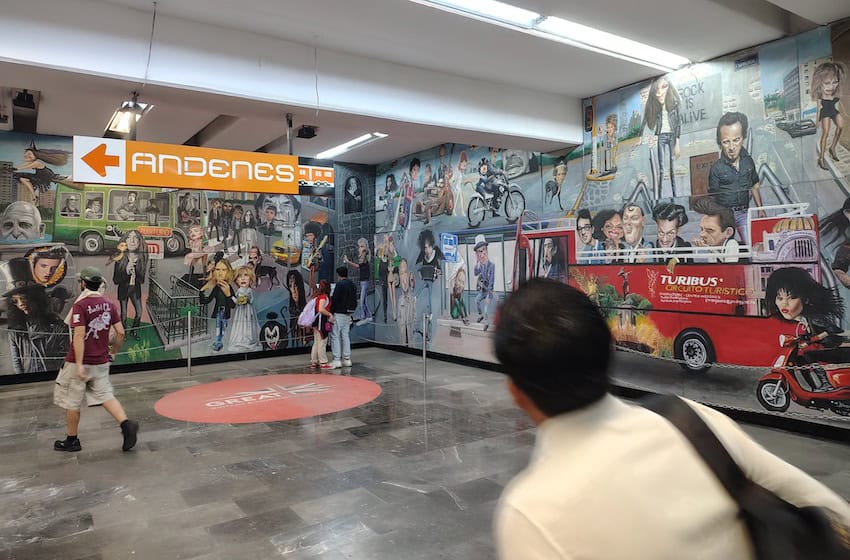
In 2018, Flores told the news site Sin Embargo that the Auditorio mural project scared him at first because he had never worked on such a large scale.
However, the long-time rock and roll fan ultimately enjoyed the process of creating the colorful and colossal artwork — and countless commuters have enjoyed observing the mural over the past decade or so since it was completed. Flores has another mural in the Chabacano Station that features Mexican rock legends.
Another artist whose work is on display in the Mexico City metro system is Jason Schell, a native of Pennsylvania. Schell, also an art teacher, has two murals in the metro system: “A Sunday Afternoon Under Mexico City” in the Cuauhtémoc station (currently closed as remodeling work on Line 1 continues) and “The Three Workers” in the Salto de Agua station.
I’ve enjoyed both artworks during my years riding the metro.
“The murals were inspired by the people of Mexico City and art history,” Schell told Mexico News Daily.
“There were direct connections to art history with those pieces, particularly other public pieces in recognition of the importance of public artwork. One was a reference to [Mexican muralist] Diego Rivera (pretty obvious), the other was Caravaggio (The Three Matthews),” he wrote in an email.
View this post on Instagram
“There is something about the grittiness of the worker pieces, and also the passenger pieces,” Schell said. “[They show] a love for everyday people and the work they do and the sacredness of all that.”
Schell said that “the fact that Mexico City exhibits art in the subway should be recognized … as completely unique and a testament to how it celebrates the arts as a city.”
As for his own opportunity to display his work to the millions of people who use the metro on a daily basis, he said:
“Like a lot of things in life, there was timing and luck involved, and being ready to take an opportunity. Muraling and street art weren’t a saturated market yet and my pieces looked unique enough to the metro authorities that they offered me the gigs.”
Schell told MND that having his murals on display in the Mexico City Metro is a “huge honor” and noted that “public transportation continues to be a source of inspiration for [his] paintings.”
“There’s something really fascinating about it all from a compositional and aesthetic standpoint: perspective, shiny metal, hundreds of different people. I just love it from an artistic standpoint,” he said.
Schell also said that “public art, particularly when it’s not embedded with too much corporate sponsorship, is incredibly important as it brings aesthetic awareness and thought, and all the vibrancy that comes with that, to the masses.”
Mexico City Metro users get that in spades.
Other must-see sights on the Mexico City Metro
Virtually all of Mexico City’s metro stations — if not all — have something of artistic and cultural value that will demand your gaze, even just for a minute or two. Many can hold your attention for much longer than that, provided you’re not in a rush to get anywhere.
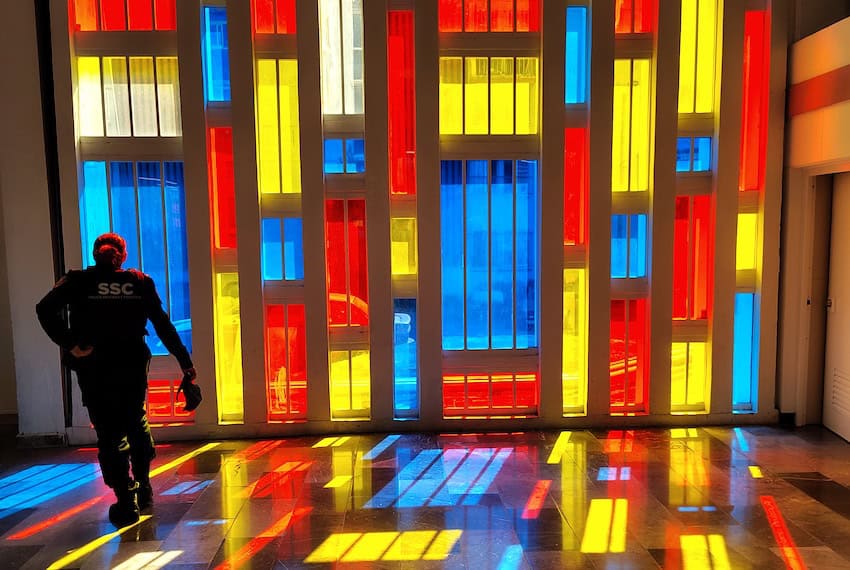
Want a Lacandon Jungle experience? Head to the Viveros station on Line 3. Want to learn about the Metro system’s history (and see its now obsolete paper tickets)? Pay a visit to the Metro Museum at the Mixcoac Station (Lines 7 and 12). Interested in Mexico’s rich history of caricature and political cartooning? Get off (or on) at Zapata station on Line 3, and catch a movie — free of charge — while you’re there. Feel like immersing yourself in the world of Mexican boxing history? Knock yourself out at the Garibaldi/Lagunilla station (Lines 8 and B).
The list goes on.
The iconography of the metro — including pictograms for each and every station — is also worth checking out. Just look up when you’re on a train and you’ll see the symbols of the line you’re traveling on maps above the windows. In the 1960s, American graphic designer Lance Wyman led the initiative to design icons to visually identify the different stations. They were (and still are) especially useful for passengers with limited literacy skills.
Toward the end of my recent day of metro traversing, I was treated to an in-carriage show by two young magicians, who performed a variety of impressive tricks — their sleight of hand art — and thus added some exuberance and awe to an otherwise ordinary trip. At the end of the performance I handed over a ten-peso coin, double the amount I paid to view all the other cultural attractions in the Metro.
But even with the additional outlay, my cultural excursion in the Mexico City Metro was still a bargain — and an enriching experience in the depths of this enchanting and amazing city.
By Mexico News Daily chief staff writer Peter Davies (peter.davies@mexiconewsdaily.com)
